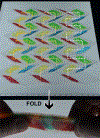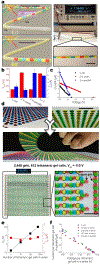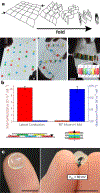An electric-eel-inspired soft power source from stacked hydrogels
- PMID: 29239354
- PMCID: PMC6436395
- DOI: 10.1038/nature24670
An electric-eel-inspired soft power source from stacked hydrogels
Abstract
Progress towards the integration of technology into living organisms requires electrical power sources that are biocompatible, mechanically flexible, and able to harness the chemical energy available inside biological systems. Conventional batteries were not designed with these criteria in mind. The electric organ of the knifefish Electrophorus electricus (commonly known as the electric eel) is, however, an example of an electrical power source that operates within biological constraints while featuring power characteristics that include peak potential differences of 600 volts and currents of 1 ampere. Here we introduce an electric-eel-inspired power concept that uses gradients of ions between miniature polyacrylamide hydrogel compartments bounded by a repeating sequence of cation- and anion-selective hydrogel membranes. The system uses a scalable stacking or folding geometry that generates 110 volts at open circuit or 27 milliwatts per square metre per gel cell upon simultaneous, self-registered mechanical contact activation of thousands of gel compartments in series while circumventing power dissipation before contact. Unlike typical batteries, these systems are soft, flexible, transparent, and potentially biocompatible. These characteristics suggest that artificial electric organs could be used to power next-generation implant materials such as pacemakers, implantable sensors, or prosthetic devices in hybrids of living and non-living systems.
Conflict of interest statement
Author Information:
The authors declare no competing financial interests.
Figures









Comment in
-
Electric fish inspire inventors across the centuries.Nature. 2018 Mar 8;555(7695):165. doi: 10.1038/d41586-018-02832-2. Nature. 2018. PMID: 29517028 No abstract available.
Similar articles
-
Powering Electronic Devices from Salt Gradients in AA-Battery-Sized Stacks of Hydrogel-Infused Paper.Adv Mater. 2021 Aug;33(31):e2101757. doi: 10.1002/adma.202101757. Epub 2021 Jun 24. Adv Mater. 2021. PMID: 34165826 Free PMC article.
-
A microscale soft ionic power source modulates neuronal network activity.Nature. 2023 Aug;620(7976):1001-1006. doi: 10.1038/s41586-023-06295-y. Epub 2023 Aug 30. Nature. 2023. PMID: 37648756 Free PMC article.
-
The cytoskeleton of the electric tissue of Electrophorus electricus, L.An Acad Bras Cienc. 2000 Sep;72(3):341-51. doi: 10.1590/s0001-37652000000300008. An Acad Bras Cienc. 2000. PMID: 11028099 Review.
-
Accordion-Structured Hydrogel Battery Capable of Maintaining Ion Gradients for Extended Periods.ACS Appl Mater Interfaces. 2024 Oct 30;16(43):58617-58627. doi: 10.1021/acsami.4c12092. Epub 2024 Oct 18. ACS Appl Mater Interfaces. 2024. PMID: 39423029
-
Electrophorus electricus as a model system for the study of membrane excitability.Comp Biochem Physiol A Mol Integr Physiol. 1998 Jan;119(1):225-41. doi: 10.1016/s1095-6433(97)00414-5. Comp Biochem Physiol A Mol Integr Physiol. 1998. PMID: 11253789 Review.
Cited by
-
Large-scale, robust mushroom-shaped nanochannel array membrane for ultrahigh osmotic energy conversion.Sci Adv. 2021 May 19;7(21):eabg2183. doi: 10.1126/sciadv.abg2183. Print 2021 May. Sci Adv. 2021. PMID: 34138731 Free PMC article.
-
Bio-Inspired Salinity-Gradient Power Generation With UiO-66-NH2 Metal-Organic Framework Based Composite Membrane.Front Bioeng Biotechnol. 2022 Apr 21;10:901507. doi: 10.3389/fbioe.2022.901507. eCollection 2022. Front Bioeng Biotechnol. 2022. PMID: 35528210 Free PMC article.
-
A Novel Gelatin-Based Sustained-Release Molluscicide for Control of the Invasive Agricultural Pest and Disease Vector Pomacea canaliculata.Molecules. 2022 Jul 2;27(13):4268. doi: 10.3390/molecules27134268. Molecules. 2022. PMID: 35807513 Free PMC article.
-
Robust sulfonated poly (ether ether ketone) nanochannels for high-performance osmotic energy conversion.Natl Sci Rev. 2020 Aug;7(8):1349-1359. doi: 10.1093/nsr/nwaa057. Epub 2020 Apr 2. Natl Sci Rev. 2020. PMID: 34692163 Free PMC article.
-
Miniaturized Salinity Gradient Energy Harvesting Devices.Molecules. 2021 Sep 8;26(18):5469. doi: 10.3390/molecules26185469. Molecules. 2021. PMID: 34576940 Free PMC article. Review.
References
-
- Bennett MVL Electric Organs in Fish Physiology (ed. Randall WSH. and D. J.) 5, 347–491 (Academic Press, 1971).
-
- Gotter AL, Kaetzel MA & Dedman JR Electrophorus electricus as a model system for the study of membrane excitability. Comp. Biochem. Physiol. A. Mol. Integr. Physiol 119, 225–241 (1998). - PubMed
-
- Sun H, Fu X, Xie S, Jiang Y & Peng H Electrochemical Capacitors with High Output Voltages that Mimic Electric Eels. Adv. Mater. 28, 2070–2076 (2016). - PubMed
-
- Kim D-H et al. Epidermal Electronics. Science 333, 838–843 (2011). - PubMed

